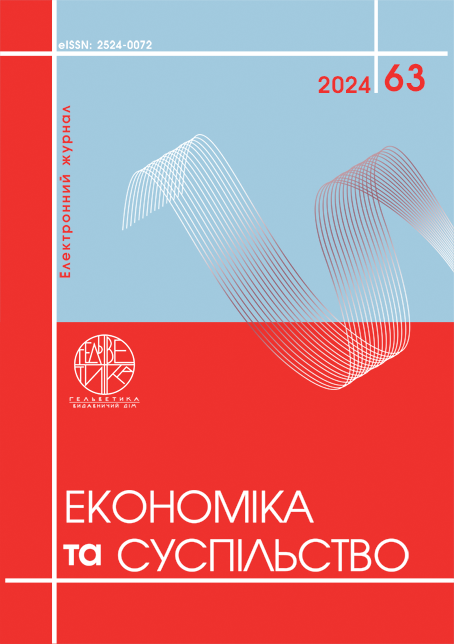BUSINESS PURPOSE IN CONTROLLED TRANSACTIONS AS A PRIORITY FOR INCREASING THE LEVEL OF FINANCIAL SECURITY OF THE ENTERPRISE IN THE CONTEXT OF TRANSFER PRICING
Abstract
The article focuses on substantiating the business purpose of controlled transactions conducted by taxpayers. The relevance of this topic is underscored by the increased scrutiny from the State Tax Service of Ukraine, which places significant importance on the presence of a legitimate business purpose for transactions, especially within the framework of transfer pricing. The goal of this study is to explore the concept of business purpose in detail, emphasizing its critical role in ensuring the financial security of enterprises. The methodology used involves a thorough analysis of the economic substance of transactions, assessing whether these transactions result in a genuine increase in the value of assets or provide other economic benefits to the taxpayer. The findings indicate that the absence of a clear business purpose in controlled transactions can expose enterprises to substantial financial risks and penalties. This risk is particularly pronounced when dealing with non-residents, where the State Tax Service is keen on identifying transactions that may be structured primarily for the purpose of tax avoidance. The analysis highlights the necessity for enterprises to meticulously document and justify the economic rationale behind each transaction to ensure compliance with tax regulations and to mitigate associated risks effectively. The practical value of this article lies in its provision of detailed guidelines for enterprises on how to ensure that their transactions are underpinned by a clear business purpose. It advises businesses to avoid transactions that do not conform to their statutory documents, involve pricing below cost, or include non-resident nominal owners or companies registered at mass registration addresses. By preparing comprehensive documentation that substantiates the economic rationale of their transactions, enterprises can significantly enhance their financial security. This proactive stance not only diminishes the probability of tax disputes but also fosters a more constructive relationship between taxpayers and tax authorities. In conclusion, the article asserts that the detailed analysis and thorough documentation of the business purpose of controlled transactions are imperative for enterprises to protect themselves against financial penalties and risks. It encourages businesses to adopt a forward-looking approach in documenting and justifying their transactions to align with regulatory expectations.
References
Варналiй З.С., Мацур С.М. Аналіз джерел інформації для трансфертного ціноутворення в умовах діджиталізації. Теоретичні та прикладні питання економіки Збірник наукових праць. Випуск 1 (44). 2022. С.4–11. DOI https://doi.org/10.17721/tppe.2022.44.1 http://tppe.econom.univ.kiev.ua/data/2022_44/index.htm
Наказ Верховної Ради України №112 від 15.03.2022. Верховна Рада України. URL: https://zakon.rada.gov.ua/rada/show/v0011201-22#Text (дата звернення: 09.06.2024).
Податковий контроль за трансфертним ціноутворенням. Державна податкова служба України. URL: https://tax.gov.ua/media-tsentr/novini (дата звернення: 09.06.2024).
Податковий кодекс України від 02.12.2010 № 2755-VI // Верховна Рада України. URL: https://zakon.rada.gov.ua/laws/show/2755-17 (дата звернення: 09.06.2024).
Постанова Верховного Суду від 28.02.2023 у справі № 160/13387/19 // ЛІГА:ЗАКОН. URL: http://verdictum.ligazakon.net/document/109259337 (дата звернення: 09.06.2024).
Романюк М. В. Трансфертне ціноутворення в податковій системі України. Світові тенденції та перспективи розвитку фінансової системи України. 2013. С. 15–17.
Verdictum. Документ № 109259337. ЛІГА:ЗАКОН. URL: http://verdictum.ligazakon.net/document/109259337 (дата звернення: 09.06.2024).
Varnaliy Z. S, Matsur S. M. (2022) Analiz dzherel informatsii dlya transfernogo tsinoutvorennya v umovakh didzhytalizatsii [Analysis of information sources for transfer pricing in the context of digitalization]. Teoretychni ta prykladni pytannya ekonomiky. Zbirnyk naukovykh prats – Theoretical and Applied Questions of Economics: Collection of Scientific Papers, 1(44), pp. 4–11. DOI: https://doi.org/10.17721/tppe.2022.44.1. Available at: http://tppe.econom.univ.kiev.ua/data/2022_44/index.htm .
Nakaz Verkhovnoi Rady Ukrainy №112 vid 15.03.2022 [Order of the Verkhovna Rada of Ukraine No. 112 dated March 15, 2022]. Verkhovna Rada Ukrainy. Available at: https://zakon.rada.gov.ua/rada/show/v0011201-22#Text (Accessed: June 9, 2024).
Podatkovyi kontrol za transfernym tsinoutvorennyam [Tax control over transfer pricing]. Derzhavna podatkova sluzhba Ukrainy. Available at: https://tax.gov.ua/media-tsentr/novini (Accessed: June 9, 2024).
Podatkovyi kodeks Ukrainy vid 02.12.2010 № 2755-VI [Tax Code of Ukraine dated December 2, 2010 No. 2755-VI]. Verkhovna Rada Ukrainy. Available at: https://zakon.rada.gov.ua/laws/show/2755-17 (Accessed: June 9, 2024).
Postanova Verkhovnoho Sudu vid 28.02.2023 u spravi № 160/13387/19 [Resolution of the Supreme Court dated February 28, 2023, in case No. 160/13387/19]. LIGA. Available at: http://verdictum.ligazakon.net/document/109259337 (Accessed: June 9, 2024).
Romanyuk M.V. (2013) Transferne tsinoutvorennya v podatkoviy systemi Ukrainy [Transfer pricing in the tax system of Ukraine]. Svitovi tendentsii ta perspektyvy rozvytku finansovoi systemy Ukrainy [World trends and prospects for the development of Ukraine's financial system], pp. 15-17.
Verdictum. Dokument № 109259337 [Document No. 109259337]. LIGA. Available at: http://verdictum.ligazakon.net/document/109259337 (Accessed: June 9, 2024).

This work is licensed under a Creative Commons Attribution 4.0 International License.


